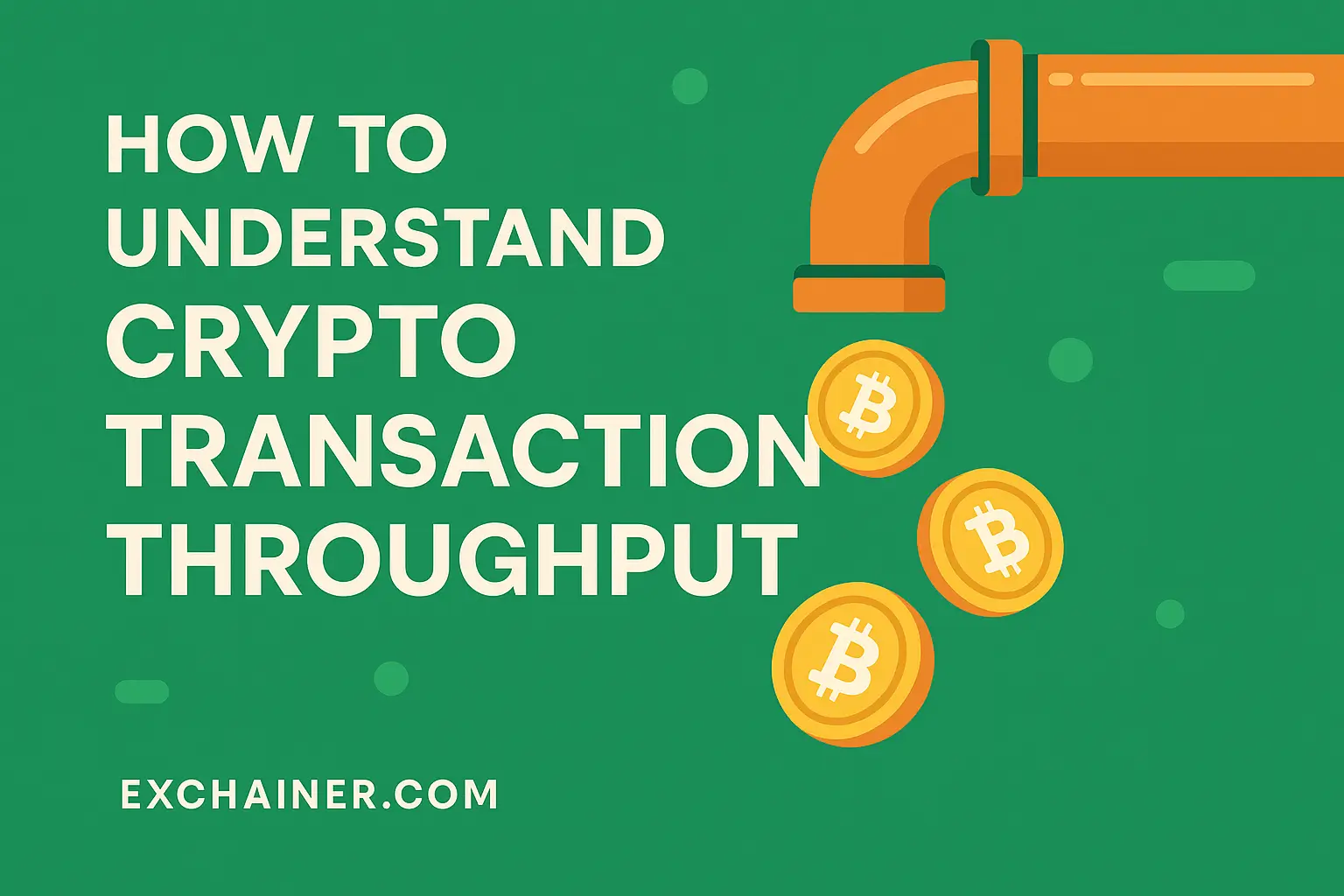Picture this: you’re ready to send some crypto to a friend or execute a trade, but your transaction keeps getting delayed, and fees suddenly seem sky-high. Frustrating, right? This is where crypto transaction throughput comes into play—a crucial, though often overlooked, concept that directly impacts your experience in the blockchain world. Simply put, crypto transaction throughput refers to how many transactions a blockchain network can process within a given time frame. It’s a key metric that shapes everything from transaction speed and cost to the overall usability of cryptocurrencies and decentralized applications (dApps).
But wait—transaction throughput isn’t just about raw speed. It differs from related terms like capacity, latency, and finality. Capacity often talks about the total volume a network can handle, latency describes the delay before a transaction is confirmed, and finality means when a transaction can no longer be reversed. Throughput specifically measures the count of transactions processed over time, making it a vital factor for developers, exchanges, and users aiming for efficient performance.
Why should this matter to you? Whether you’re trading on a popular exchange, using a DeFi app, or just curious about how cryptocurrencies work under the hood, understanding throughput gives you insight into why some networks slow down or charge hefty fees during peak times. It also explains how developers decide which blockchain to build on and what upgrades might improve your experience.
In this guide, we’ll break down the core metrics behind throughput, the technical factors that drive it, how to accurately measure it, the most common bottlenecks, and the innovative scaling strategies that help modern blockchains handle more transactions seamlessly. By the end, you’ll have a clear framework to evaluate throughput across different blockchain platforms and make informed choices on your crypto journey.
Transactions Per Second (TPS)
TPS Defined vs. Other Throughput Metrics
When people hear “crypto transaction throughput,” one of the most common terms they encounter is transactions per second (TPS). TPS essentially measures how many individual transactions a blockchain can process every second. This metric is a straightforward way to quantify throughput — think of it as a car’s speedometer telling you how fast it’s traveling.
However, it’s important to recognize differences here. TPS is a raw rate focusing purely on volume over time, while throughput can sometimes adapt to include considerations such as how many successful transactions vs. failed ones occur, or the complexity of these transactions. Also, there’s often a distinction between theoretical peak TPS — the maximum possible if conditions were ideal — and sustained TPS, which is what the network realistically supports during regular use.
How TPS is Calculated On-Chain
Calculating TPS might sound straightforward, but it involves several blockchain-specific parameters. At its core, TPS depends on three main factors: the number of transactions in each block, how often blocks are created (block time), and block size or gas limits.
Imagine a blockchain that produces one block every 10 seconds, with each block containing 200 transactions. The TPS calculation is:
TPS = Number of transactions per block ÷ Block time in seconds
So, 200 transactions ÷ 10 seconds = 20 TPS.
Still, it’s not always that simple. Some transactions bundle multiple operations (like smart contract interactions), so the effective workload might be higher than apparent through just transaction count. Similarly, techniques like batching can group many payments in a single transaction, which affects how you interpret raw TPS numbers.
Real-World TPS Benchmarks and Comparisons
For context, Bitcoin’s TPS hovers around 3 to 7, thanks to its roughly 10-minute blocks capped at 1MB size. Ethereum, before the Merge upgrade in 2022, handled about 15-30 TPS, with the new PoS consensus promising improved throughput in the future.
To put this into perspective, consider Visa’s network, which can process around 1,700 to 24,000 TPS depending on peak demand. PayPal boasts processing speeds similar to Visa. This highlights why cryptocurrencies still face challenges in replacing traditional payment systems outright—throughput limitations remain a core hurdle.
But remember, higher TPS alone doesn’t guarantee a better network. Security, decentralization, and consensus stability matter too.
Block Parameters and Network Design
Block Size Impact on Throughput
At the heart of throughput lies the block size or gas limit. Block size determines how much data a single block can carry, effectively limiting how many transactions can fit inside. Larger blocks can accommodate more transactions, potentially increasing throughput.
But bigger isn’t always better here. Increasing block size means longer times to propagate new blocks across the network, leading to greater chances of blockchain forks (temporary splits) and centralization risks as only more powerful nodes can handle bigger data loads. Developers often face a trade-off between improving throughput and maintaining network decentralization.
Block Time, Confirmation Rate, and Perceived Throughput
Block time—the interval between blocks—also impacts throughput and user experience. Shorter block times allow faster transaction confirmations, reducing the wait to see your crypto move.
Yet, shortening block time comes at a cost: increased orphan or stale blocks occur when competing blocks get rejected, potentially reducing overall efficiency. So, blockchain networks must find sweet spots between latency (how fast transactions are confirmed) and reliability.
Consensus Rules and Network Propagation Effects
The consensus mechanism—how blockchain participants agree on the next block—affects throughput too. For example, Proof of Work (PoW) like Bitcoin’s tends to have longer confirmation times and lower throughput but is very secure. Proof of Stake (PoS) and Byzantine Fault Tolerant (BFT) algorithms can offer faster finality and higher throughput but with different trade-offs.
Network conditions such as bandwidth and latency also influence effective throughput. Even if block parameters are optimized, poor network propagation can bottleneck transaction processing.
Measuring Throughput in Practice
Key Metrics Beyond TPS: Latency, Finality, and Success Rate
TPS alone doesn’t tell the whole story. Other important metrics include:
Latency: Time from submitting a transaction until it’s confirmed. Lower latency means faster user experience.
Finality: When a transaction becomes irreversible. Some networks provide near-instant finality, while others require multiple confirmations.
Success rate: Percentage of transactions successfully processed without errors or rejections.
Paying attention to these ensures you’re not just looking at raw speed but how smooth and reliable the network really is.
Tools and Methodologies for Testing Throughput
Testing throughput requires practical tools—such as load testing frameworks, testnets, and monitoring platforms. Developers use these to simulate transaction volumes and evaluate network behavior. Popular tools include block explorers for real-time monitoring, mempool analytics to track pending transactions, and simulators that mimic smart contract workloads.
Setting up a basic test environment involves submitting transactions at controlled rates, observing confirmation times, and recording failure patterns. This hands-on approach helps identify bottlenecks before they impact live users.
Interpreting Results and Common Measurement Pitfalls
Interpreting throughput results is trickier than it sounds. Synthetic tests may not reflect real-world complexities like varying transaction sizes or smart contract processing times. Test environments might benefit from ideal network conditions, giving optimistic readings. So, sample size, transaction diversity, and network state should be considered to avoid misleading conclusions.
Scaling Strategies and Trade-offs
On-Chain Scaling Approaches
Increasing throughput on-chain usually involves:
– Bigger blocks or higher gas limits, allowing more transactions per block.
– Protocol-level changes like optimizing consensus algorithms or enabling parallel transaction processing.
However, these methods can introduce risks: network bloat, increased hardware demands, and potential centralization.
Off-Chain and Layer 2 Solutions
To bypass on-chain limitations, blockchain projects use off-chain or Layer 2 solutions:
– State channels let users transact off-chain, with only final states settled on-chain, cutting confirmation times drastically.
– Sidechains are separate blockchains anchored to the main chain, sharing security but allowing more transactions.
– Optimistic and Zero-Knowledge (ZK) rollups bundle many transactions off-chain and submit succinct proofs on-chain, boosting throughput without sacrificing security.
Each approach has trade-offs balancing security, decentralization, user experience, and implementation complexity.
Hybrid Models and Trade-offs (Security, Decentralization, Cost)
Advanced scaling combines sharding—splitting the network into smaller parts—and rollups or Layer 2 chains. This layered architecture promises massive throughput gains but requires careful coordination to maintain strong security and decentralization.
Choosing the right solution depends on use case priorities: some applications demand utmost security, others prioritize speed and low cost.
Conclusion
Understanding crypto transaction throughput unlocks the door to grasping how blockchain networks handle the complex flood of transactions driving today’s crypto ecosystem. We’ve explored that throughput primarily measures how many transactions per second (TPS) a network can sustain, shaped by factors like block size, block time, consensus algorithms, and network conditions.
Measuring throughput in practice involves more than raw TPS: metrics like latency, finality, and success rate matter just as much to ensure a seamless user experience. Handy tools and testing methodologies provide insights, but interpreting results critically is essential to avoid common pitfalls.
When it comes to scaling, a spectrum of solutions from on-chain enlargements to off-chain Layer 2 innovations highlight the balancing act between speed, security, decentralization, and cost. Hybrid models combining these approaches showcase the future of blockchain scalability.
Folks interested in evaluating throughput for their projects can start by gathering relevant metrics from blockchain explorers and monitoring tools, run load tests on testnets to simulate traffic, and keep an eye on network performance reports. Always consider if priority lies in maximum throughput or preserving strong decentralization and security — it’s rarely a one-size-fits-all answer.
Ready to dive deeper and sharpen your crypto knowledge? Check out these valuable resources on Exchainer’s Crypto 101, explore detailed Exchange Reviews to pick the right trading platform, or enhance your security with tools from our Tools and Wallets section. The world of crypto is vast, but with a solid grasp of transaction throughput, you’ll be better equipped to navigate it confidently.
If you want to see how top blockchains like Ethereum plan to boost throughput with Ethereum 2.0, visit the official Ethereum 2.0 roadmap. For real-time TPS stats across blockchains, CoinMarketCap’s blockchain data serves as an excellent reference.












